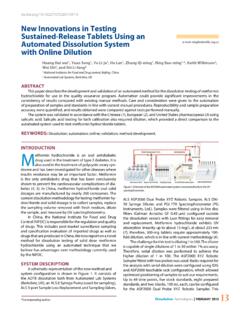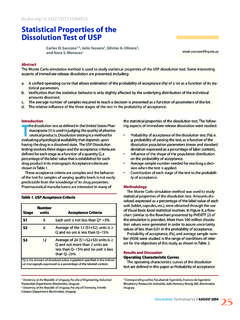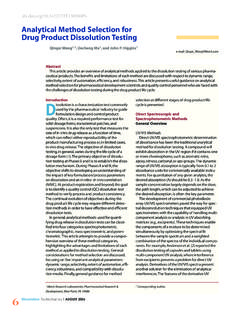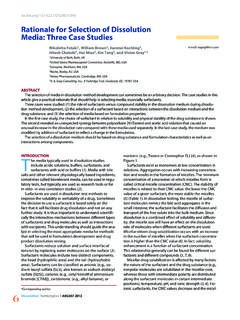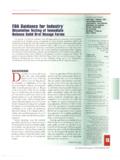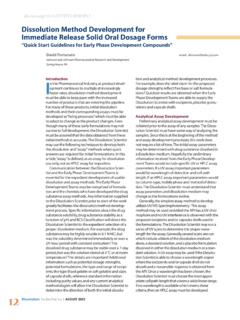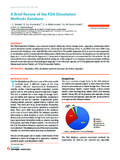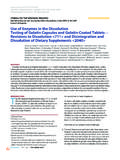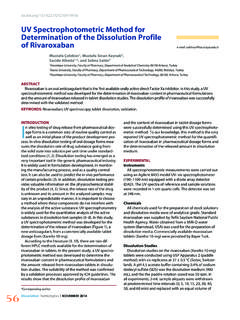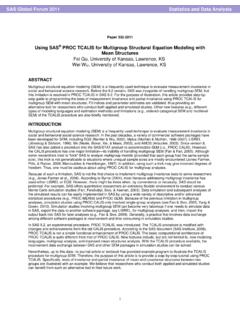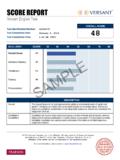Transcription of In Vitro Dissolution Curve Comparisons: A Critique …
1 In Vitro Dissolution Curve Comparisons: A Critique of Current Practice Dave LeBlond1,*, Stan Altan2, Steven Novick3, John Peterson4, Yan Shen2, and Harry Yang5 e-mail: 1 CMC Statistics Consultant, Wadsworth, IL 60083. 2 Janssen Research & Development LLC, Raritan, NJ 08869. 3 GlaxoSmithKline Pharmaceuticals, Research Triangle Park, NC 27709. 4 GlaxoSmithKline Pharmaceuticals, Collegeville, PA 19426. 5 MedImmune LLC, One MedImmune Way, Gaithersburg, MD 20878. ABSTRACT. Many pharmacologically active molecules are formulated as solid dosage form drug products. Following oral administration, the diffusion of an active molecule from the gastrointestinal tract into systemic distribution requires the disintegration of the dosage form followed by the Dissolution of the molecule in the stomach lumen.
2 Its Dissolution properties may have a direct impact on its bioavailability and subsequent therapeutic effect. Consequently, Dissolution (or in Vitro release) testing has been the subject of intense scientific and regulatory interest over the past several decades. Much interest has focused on models describing in Vitro release profiles over a time scale, and a number of methods have been proposed for testing similarity of profiles. In this article, we review previously published work on Dissolution profile similarity testing and provide a detailed Critique of current methods in order to set the stage for a Bayesian approach.
3 KEY WORDS: Dissolution profile similarity; in Vitro release; f2 statistic; Bayesian model. INTRODUCTION Dissolution testing has played an increasingly important M. any pharmacologically active molecules are role in drug development. formulated as immediate-release (IR) solid dosage form drug products. Following oral The 1997 FDA guidance on Dissolution testing (2). administration, the diffusion of an active molecule from describes three important uses for it: (1) assess lot-to- the gastrointestinal tract into systemic distribution lot quality of a drug product, (2) guide development of requires the disintegration of the dosage form followed new formulations, and (3) ensure continuing product by the Dissolution of the molecule in the stomach lumen.
4 Quality and performance after certain events, such as Its Dissolution properties may have a direct impact on changes in formulation, the manufacturing process, the its bioavailability and subsequent therapeutic effect. site of manufacture, or scale-up of the manufacturing Consequently, Dissolution (or in Vitro release) testing process. In addition, for certain drugs, in Vitro Dissolution methods have been studied as possible surrogates for results might be sufficient to gain regulatory approval for human bioavailability studies in addition to product post-marketing changes and waiver of bioequivalence quality control.
5 Requirements for lower-strength dosage forms as described by Moore and Flanner (3). A formal similarity In Vitro Dissolution testing as an analytical methodology evaluation is a regulatory requirement for this purpose measures drug release in liquid media. The method as described in FDA guidances (2, 4 8) and the 2008. requires specialized laboratory equipment, following a EMA guidelines (9). Thus, the question of demonstrating well-defined protocol such as described in the United similarity or equivalence between the reference and test States Pharmacopeial convention reference (1).
6 In Vitro drug Dissolution curves is of both scientific and regulatory Dissolution testing is frequently used as a surrogate importance. measure of bioavailability. This avoids the risk and expense of human trials and facilitates the implementation of Various methods comparing drug Dissolution profiles improvements in processes and products. Authorization have been proposed. In general, they can be classified into to market a generic compound also makes use of three categories: model-independent approaches based Dissolution profile comparisons. Consequently, in Vitro on a similarity factor; model-independent methods using *Corresponding author.
7 14 Dissolution Technologies | FEBRUARY 2016. multivariate statistical distance (MSD) test; and model- given by Moore and Flanner (3) based on the index of dependent methods using parametric curves to describe Rescigno (12) originally used to compare plasma drug Dissolution profiles. concentration curves and mean Dissolution times. As with f2, these methods do not explicitly define the hypothesis Model-Independent Approach Based of similarity, nor do they have the ability to demonstrate on the f2 Similarity Statistic operating characteristics of the tests such as Type I and II.
8 Moore and Flanner (3) proposed a model-independent errors. approach to measure the similarity between drug Dissolution profiles of a test and reference formulation. Model-Independent Multivariate Approach The method includes calculations of two mathematical Another class of model-independent methods hinges on indices: the normality assumption underlying the in Vitro release . k | Ri Ti |. f1 = i =1. 100 values observed at different time points and constructs Ri k and i =1 a measure of distance between two sets of multivariate random variables. Consider a Dissolution study with times ti, i = 1, , k.
9 Let R and T denote the vectors of sample 1 k . 1 / 2. f 2 = 50 log10 100 1 + i =1 wi ( Ri Ti ) 2 means, respectively, for reference and test Dissolution k measurements across k time points and let Sp be the pooled sample covariance matrix. Thus where Ri and Ti are reference and test results, respectively, T 2 = n1n2 (n1 + n2 ) 1[( R T ) ( R T )]' S p 1[( R T ) ( R T )]. at time ti, i = 1, , k, and wi is an optional weight factor. is the Hotelling's T 2 statistic. It can be shown that Subsequently, a similarity test procedure based on the n1 + n2 k 1 2. T. difference factor f1 and similarity factor f2 with wi = 1 ( n1 + n2 2)k follows an F distribution with k and was recommended in the FDA guidances for Dissolution profile comparison (2, 5 8).
10 Note that f2 = 100 when the n1 + n2 - k -1 degrees of freedom. A 95% confidence region two Dissolution curves are identical. When f2 50 ( , of R T is obtained as follows: when |Ri Ti| 10 for all i), the two Dissolution profiles are C ( R , T , S ) = T 2 ( n1 + n2 2)k F . deemed to be similar according to the FDA guidance for p k ,n + n k 1; . n1 + n2 k 1 1 2.. immediate-release (IR) solid oral dosage forms (2). While not explicitly stated, inference based on f2 is seemingly where Fk , n1 + n 2 k 1, denotes the 5% quantile of an intended to test the null hypothesis: H0: f20 < 50 versus F-distribution with the given degrees of freedom.
